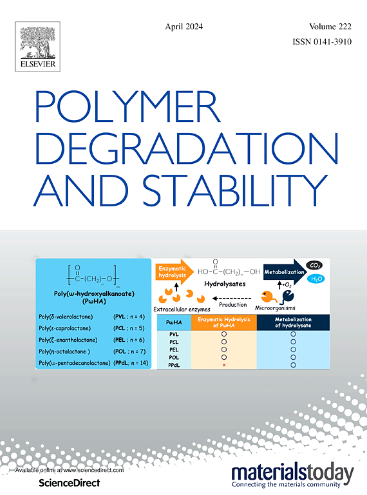Disintegration of commercial single-use plastics from synthetic and biobased origins and effects on plant growth
IF 6.3
2区 化学
Q1 POLYMER SCIENCE
引用次数: 0
Abstract
Many single–use plastic (SUP) options made of synthetic polymers, bio-based materials, and blends of both are available in the market and used in large quantities. The disintegration of eleven commercial SUP, marketed in Mexico as cups and plates, was investigated in an aerobic home compost environment at a laboratory scale over 180 days. An evaluation of chemical changes, surface morphology, and thermal and mechanical properties was conducted to ascertain the original composition of SUP and the progression of disintegration in samples that are challenging to clean from soil contamination. Furthermore, the impact of residual compost on barley (Hordeum vulgare) plant growth and its correlation with the leaching of heavy metals were explored. The bio-based SUP, but not those made of expanded polystyrene foam, showed a correlation between the disintegration degree (measured by weight loss into particles <2 mm) and a decrease in functional groups (observed by FT-IR), mechanical-thermal stability loss, and surface wear over disintegration time. For instance, the highest disintegration at 180 days was approximately 70 % for wheat bran and palm leaf plates, followed by wheat plates and cellulose-PLA cups (60 %). In addition to the components listed by the manufacturers, the FT-IR and DSC analysis revealed the presence of polyethylene and polypropylene in cellulose cups and sugarcane plates. These components, impede disintegration but contribute to preserving thermal resistance and hydrophobicity during utilization. Compost derived from expanded polystyrene foam SUP, with 90 days of disintegration, was rich in zinc and chromium and significantly decrease in the root length of the barley plant compared to the control. This demonstrates the necessity of considering the impact of the leaching of additives and secondary microplastics into the environment.
源于合成和生物的一次性商用塑料的分解及其对植物生长的影响
市场上有许多由合成聚合物、生物基材料以及两者的混合物制成的一次性塑料(SUP),并被大量使用。在实验室规模的有氧家庭堆肥环境中,对墨西哥市场上销售的 11 种商用杯盘一次性塑料的分解情况进行了 180 天的调查。对化学变化、表面形态以及热和机械性能进行了评估,以确定 SUP 的原始成分以及难以从土壤污染中清除的样品的分解过程。此外,还探讨了残留堆肥对大麦(Hordeum vulgare)植物生长的影响及其与重金属沥滤的相关性。生物基 SUP(而非发泡聚苯乙烯制成的 SUP)的崩解度(以重量损失为 2 毫米的颗粒来衡量)与功能基团的减少(通过傅立叶变换红外光谱观察)、机械热稳定性的降低以及崩解时间的表面磨损之间存在相关性。例如,180 天时,麦麸和棕榈叶板的崩解率最高,约为 70%,其次是小麦板和纤维素-聚乳酸杯(60%)。除了制造商列出的成分外,傅立叶变换红外光谱和 DSC 分析还显示纤维素杯和甘蔗板中含有聚乙烯和聚丙烯。这些成分会阻碍分解,但有助于在使用过程中保持耐热性和疏水性。由发泡聚苯乙烯泡沫 SUP 制成的堆肥在 90 天的分解过程中富含锌和铬,与对照组相比,大麦植株的根长明显减少。这表明有必要考虑添加剂和二次微塑料沥滤对环境的影响。
本文章由计算机程序翻译,如有差异,请以英文原文为准。
求助全文
约1分钟内获得全文
求助全文
来源期刊

Polymer Degradation and Stability
化学-高分子科学
CiteScore
10.10
自引率
10.20%
发文量
325
审稿时长
23 days
期刊介绍:
Polymer Degradation and Stability deals with the degradation reactions and their control which are a major preoccupation of practitioners of the many and diverse aspects of modern polymer technology.
Deteriorative reactions occur during processing, when polymers are subjected to heat, oxygen and mechanical stress, and during the useful life of the materials when oxygen and sunlight are the most important degradative agencies. In more specialised applications, degradation may be induced by high energy radiation, ozone, atmospheric pollutants, mechanical stress, biological action, hydrolysis and many other influences. The mechanisms of these reactions and stabilisation processes must be understood if the technology and application of polymers are to continue to advance. The reporting of investigations of this kind is therefore a major function of this journal.
However there are also new developments in polymer technology in which degradation processes find positive applications. For example, photodegradable plastics are now available, the recycling of polymeric products will become increasingly important, degradation and combustion studies are involved in the definition of the fire hazards which are associated with polymeric materials and the microelectronics industry is vitally dependent upon polymer degradation in the manufacture of its circuitry. Polymer properties may also be improved by processes like curing and grafting, the chemistry of which can be closely related to that which causes physical deterioration in other circumstances.
 求助内容:
求助内容: 应助结果提醒方式:
应助结果提醒方式:


